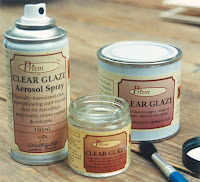There are many different brands including Fimo, Sculpey, Gedeo and many others, which all offer different finishes for your clay work. Some leave a matt finish others a satin finish and others a glossy finish. Not to mention the different sizes and prices of each product. If you use the wrong type of varnish the finish may look fine to start with but could soon start to peel or become sticky later. Others may start yellowing or cause the paint or clay to react and loose the colouring.
Here is an overview of some of the more common varnishes and
glazes and clay they are best suited for. It is recommended that you always
read the manufacturer’s instructions and experiment with a few different varnishes on your clay to ensure they leave a perfect finish.
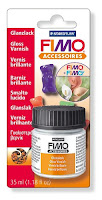
Fimo Gloss Varnish is recommended for glazing all types of polymer clay including Sculpey clay. It is a water based lacquer that is available in small pots. It has a milky consistency when in the jar but will dry completely transparent. It leaves a shiny gloss finish to your clay work.

Fimo Gloss Varnish is recommended for glazing all types of polymer clay including Sculpey clay. It is a water based lacquer that is available in small pots. It has a milky consistency when in the jar but will dry completely transparent. It leaves a shiny gloss finish to your clay work.
It is usually touch dry
after 20 minutes, although it should be left to dry completely for 24 hours. It
is important to ensure your sculpture is completely clean and dry before
applying the varnish. Using an artist paint brush apply the first coat. Allow
the varnish to dry completely before applying a second coat.

Fimo Deco Gel / Liquid Polymer Clay is a bakeable transfer medium that can be used for a wide range of things including glazing. It can be used to transfer images, decorate as a protective coat, act as a sealer and can also be mixed with paints and powders.
It should be baked in an oven for approximately
20 minutes at 130 degrees Celsius. Once baked it leaves a matte translucent finish that is
both flexible and durable. It can be used for polymer clay mosaic grout, faux enamelling, stained glass effect sun catchers and colour transfers from printed
images, as well as lots more. By adding oil paints to the liquid clay you can
create a bake-able painting and surface medium or add dry pigments to create
glazes and colour washes.
Sculpey
Liquid Polymer Clay Bakeable / Sculpey Translucent
Liquid are bake-able liquid transfer mediums that are used as a clay softener and adhesive for Sculpey and polymer clay's. They are also
great for glazing polymer clay creations just like a varnish.
Used as a clay softener Sculpey liquid helps to rejuvenate and
improve the texture of clay and make it easier to work with. It is perfect for
any clay that has become dry and crumbly. It only requires a few drops of the
liquid added to the clay, which is then kneaded until the clay becomes soft and
pliable again.
It can also be used as enamel, a glaze for laminating projects, or a back-filling compound or it can be mixed with mica powders for lots of other possibilities. By adding oil paints to the liquid it becomes a bake-able painting medium or use clear to create glass effects.
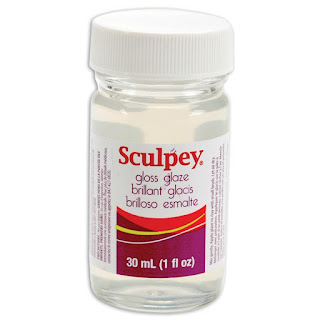 Sculpey Multi-Use
Acrylic Varnish is a water based gloss or satin polymer clay varnish, which Sculpey says will protect your
clay work creations and give them a new finish.
Sculpey Multi-Use
Acrylic Varnish is a water based gloss or satin polymer clay varnish, which Sculpey says will protect your
clay work creations and give them a new finish.
This varnish can be added to cured or uncured clay. When glazing
cured clay allow 30 minutes between each coat in order to allow each layer to
dry. If applying to uncured clay allow the varnish to dry completely then bake
at 130 C (275 F) for 30 minutes. Apply using a small brush
and add thin layers at a time. It can be mixed with water to thin out the
varnish.
It can be used on other clay's, such as air dry, oven cured or kiln baked clay. This varnish is also fine to use as a glaze on clay projects that have been painted with acrylic paints and it will protect the paint and add a shine to the paint and enhance the colour. It also gives a good glaze on polystyrene and can be used as a decoupage glue and varnish.
The varnish can be used prior to baking or after the clay creation has been baked and Sculpey says it will not peel. Some artists have found the glaze to peel but Beads and Beading Blog offers some great advice for this common problem and suggests that this is “most likely caused by excess oils from your hands getting on your beads causing the glaze to not stick properly. You can solve this problem by sanding (highly recommended) and/or cleaning the bead first with rubbing alcohol before coating with the glaze. For beads that have already peeled, you can bake them for 10 min or so and see if that works”.
It can be used on other clay's, such as air dry, oven cured or kiln baked clay. This varnish is also fine to use as a glaze on clay projects that have been painted with acrylic paints and it will protect the paint and add a shine to the paint and enhance the colour. It also gives a good glaze on polystyrene and can be used as a decoupage glue and varnish.
The varnish can be used prior to baking or after the clay creation has been baked and Sculpey says it will not peel. Some artists have found the glaze to peel but Beads and Beading Blog offers some great advice for this common problem and suggests that this is “most likely caused by excess oils from your hands getting on your beads causing the glaze to not stick properly. You can solve this problem by sanding (highly recommended) and/or cleaning the bead first with rubbing alcohol before coating with the glaze. For beads that have already peeled, you can bake them for 10 min or so and see if that works”.
 Polyurethane Varnish is basically a plastic liquid and is available in both water- and oil-based with a matt or gloss finish . It can be used on a number of mediums including air dry clay, polymer clay, kiln fired clay, wood and other types of craft mediums.
Polyurethane Varnish is basically a plastic liquid and is available in both water- and oil-based with a matt or gloss finish . It can be used on a number of mediums including air dry clay, polymer clay, kiln fired clay, wood and other types of craft mediums.
Water based Polyurethane Varnish provides a clear coating that does not discolour
and dries quickly. It can deteriorate if exposed to heat and chemicals so is
best used for clay work for display purposes rather than practical use creations.
There are some water based polyurethanes that are more durable but it is
important to do more research before applying to you art work. When completely dry it is
water resistant and transparent. Polyurethane Varnish can also be used as a and
adhesive and varnish when gluing and glazing decoupage craft items. It will
also seal and enhance polystyrene products. It is ideal for use over acrylic
paint to give added protection and to gloss up and enhance the colours.
Oil based polyurethane varnish may discolour slightly, creating a
yellowing colour especially to light colours. It takes longer to dry but is
much more durable when exposed to heat, cold or other extremes. When working
with oil-based polyurethane, use a respirator in a well-ventilated area. Use a natural-bristle
brush or rag when applying oil based varnish. It takes much longer to dry and cure than
water-based, so plan accordingly and follow the manufacturer's directions.
Prism
Clear Glaze
is a gloss varnish that
will dry clear and enhance shine and colour of the clay and/or paints. It can
also be used on paper crafts, decoupage and plaster casts as well as lots of
other mediums. Ensuring the surface is
clean and dry apply the varnish with a small brush. When possible sand the
creations to make a smooth surface beforehand and for best results apply several
layers of varnish but allow each coating to dry overnight before applying the
next.
Gedeo
Varnish is available
in matt and gloss finish that has a lacquer type consistency. It is a water
based varnish that provides a clean, clear glaze over your finished products.
As with other varnishes ensure the surface is clean and completely dry and
apply the varnish with a flat soft bristles brush.
It
is almost transparent when in liquid state and will leave a clear transparent
finish once completely dry. Apply 2 – 3 coats in order to provide sufficient
protection to your clay work. Allow each coat to dry completely before applying
a second layer.
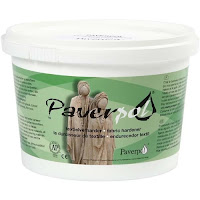
Paverpol Liquid Sculpting Medium is used as a fabric hardener but is also ideal for glazing most materials including air dry and polymer clay. It provides a waterproof and weatherproof finish and can be used on sculptures, jewellery, garden ornaments and lots of other clay creations and crafts. It dries fairly quickly but long enough to work with without drying out. Always allow to completely dry if applying a second coat i.e with garden ornaments.
In liquid form it has a similar look and consistency to PVA glue and dries to a hard transparent finish. Paverpol is available in a number of colours including transparent, bronze, grey and black. It can be used with fabric, paper, silk, metal, baked polymer clay, self-hardening clay, polystyrene foam, dried flowers, Paper Mache, wood, plaster, metal, glass, pottery, on canvas. (Parverpol will not adhere to plastic).
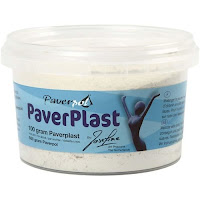 Mix Paveplast with Paverpol to make a paste
suitable for creating pieces of work that remain watertight, such as bird baths,
outdoor sculptures etc.
Mix Paveplast with Paverpol to make a paste
suitable for creating pieces of work that remain watertight, such as bird baths,
outdoor sculptures etc.
Using Parvepol for small pieces of clay work,
attach a paperclip or thin string to the creation and dip the piece in the liquid
until it is completely covered. Remove from the liquid and hold over the tub
for a few minutes to allow the excess to drip in the tub. Hang the piece up so
that it is not touching anything and place a sheet of paper underneath to catch
any excess drips. Dab the end of the creation where the liquid is dripping
every ten minutes until it stops producing a drip (approximately 30 minutes). Where it is not possible
to use a paperclip or string on the piece attach a piece of Blutac to the back
of the creation. Attach the flat head of a long nail to the Blutac and dip in
the Parvepol. Once completely covered stick the nail in a polystyrene block and
follow the drying process as explained.


Liquitex Gloss Medium and Varnish is a suitable for glazing your clay work as well as having a number of other uses. It can be used as an adhesive and transfer medium. It can also be mixed with acrylic paints to create a colour tinted glaze. It is a thick milky liquid similar to Parvepol that can be thinned by adding a further 25% water.
Liquitex is not suitable for glazing polymer clay as it makes the clay work sticky after a while but works well with air dry clay. It can change the appearance slightly on intricate detail so it is best to test the product first.
**********************


